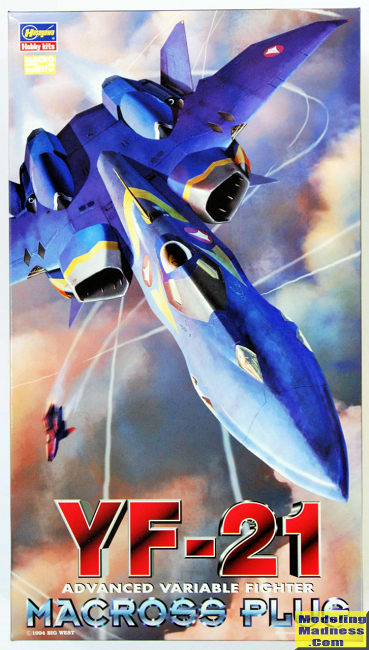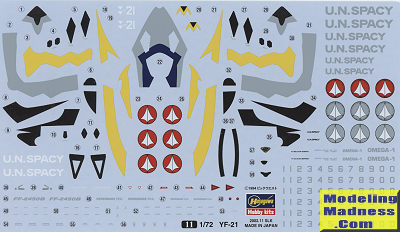Hasegawa 1/72 Macross Plus YF-21
|
KIT #: |
65711 |
|
PRICE: |
2400 yen SRP |
|
DECALS: |
One Option |
|
REVIEWER: |
Scott Van Aken |
|
NOTES: |
2002 boxing |

The General
Galaxy YF-21 was built for the Project Super Nova Advanced Variable Fighter
(AVF), a competition for a contract with the United Nations Air Force (UNAF)
and United Nations Spacy (UNS) to replace the older VF-11 Thunderbolt main
variable fighter. When the UNAF announced General Galaxy as one of two final
demonstration/validation phase contractors, the company produced two prototypes
and a ground based avionics test bed. Development on the YF-21 began in 2034 and
produced prototype No. 1 for first flight in 2039. However, it was the first
flight of the YF-21 prototype No. 2 at New Edwards Test Flight Center on
Planet Eden in January 2040 that General Galaxy revealed the true nature of
their next generation fighter. The second prototype eschewed the conventional
control cockpit of protoype No. 1 and was integrated with two experimental
systems designated brain direct interface system (BDS) and brain direct image
system (BDI) in an attempt to achieve unification of pilot and airframe. The BDS
allowed the pilot of the YF-21 to operate every control at will and BDI offered
an unprecedented view around the craft. Equipping the YF-21 with this unique
control system that improved pilot response time and situational awareness, as
well as an airframe of advanced composite material that could alter wing
shape/size, it was clear General Galaxy was determined to win the competition
with a technologically superior craft with a key characteristic being an
emphasis on high mobility performance.
The YF-21 was built with several technologies common to
itself and the competing YF-19 from Shinsei Industries ; notably an active
stealth system, an optional fold booster for interstellar travel and arm-mounted
anti-projectile shields (doubling as tail stabilizers in fighter mode). Both
variable fighters also employed a new fighter-scale pin-point barrier system,
which produced movable spheres of super dimension energy upon the exterior hull
of the craft for repelling incoming fire. Zentradi technology was also
implemented in the YF-21 Battroid mode by adopting an enhanced version of the Quimeliquola Queadluun-Rau special
inertia vector control system (the YF-21 shares a similar silhouette to that
Zentradi mecha). The offensive weaponry of the YF-21 includes a rearward firing
super-miniature anti-aircraft laser turret, two forward/rearward laser beam
guns, four internal all-environ rapid-fire micro-missile launchers and lastly
two Howard/General GV-17L cartridge-less Gatling gun pods featuring retractable
grips and stealth covers. In test sorties the YF-21 achieved performance results
far beyond last generation variable fighters and the BDS/BDI system was clearly
a recognizable improvement over conventional control systems. The YF-21 made use
of variable wing cant for incredible speed and, like the YF-19, could achieve
satellite orbit unassisted. While most VFs have traditionally situated the main
engines within the legs of the Battroid, the YF-21 arranged the engine block in
the main body with independent legs. By discarding the mostly dead weight of the
arms and legs, the limiter-release mode can attain performance reaching the
fuselage design limits and attain high manueverability combat performance
exceeding other VFs. However, the pilot operating the limit-release mode bears
the effect of dangerous G-forces which exceed the limits of the human body.
While the YF-21 was a groundbreaking fighter, development of the craft was
hindered by several misfortunes and technologies of questionable practical worth
that were either unreliable (BDI/BDS) or too expensive for mass production
(composite material wing).
 This
one is designed a bit differently from some of the other Macross fighters I've
seen. There is a nicely done cockpit tub, the contents of which will be pretty
well invisible unless you pose the canopy open. A pilot figure is also included.
The bottom of the tub is the roof of the nose gear well. The instructions would
have you attach the nose gear to the well and then trap this between the forward
fuselage halves. There seems to be room to install the gear after painting so
that is what I'd do.
This
one is designed a bit differently from some of the other Macross fighters I've
seen. There is a nicely done cockpit tub, the contents of which will be pretty
well invisible unless you pose the canopy open. A pilot figure is also included.
The bottom of the tub is the roof of the nose gear well. The instructions would
have you attach the nose gear to the well and then trap this between the forward
fuselage halves. There seems to be room to install the gear after painting so
that is what I'd do.
The broad rear fuselage is split horizontally and
there are the usual baffles to install prior to assembling the halves. There are
intake trunks, though they are not very deep. Exhaust are not movable as they
were on the Sv-262 I built a while back. Interestingly, there is a another lower
fuselage piece that appears to cover some lower engine exhaust doors. Wings are
an upper and lower half and those who want clear tip lights will need to cut the
molded in ones to install them.
As with the nose gear, it looks like you can install
the F-15 style main gear legs after the model is nearly complete. There are two
boosters/guns on the lower fuselage and the usual number of clear sensors for
the nose as well as antennas and such. No stand is provided, but Hasegawa does
make one that is designed for the Macross line of fighters. This means you can
build the kit gear up if you so wish.
 Since these
kits are for the home market, there is very little English in the instructions,
but that isn't an issue. Gunze paint references as usual. The airframe is an
overall blue (Cobalt blue with a touch of black) and so Hasegawa has molded the
kit in a blue plastic. Interestingly, the decals are not as extensive as on some
other kits and there are no metallics so there shouldn't be any issues using
these. It might be worth while to paint the inside and outside of the intakes
which are listed as light gull grey with a touch of cobalt blue, but I wouldn't
bother painting much else that is supplied as a decal. The sheet is nicely
printed and provides some serial number options if you are so inclined.
Since these
kits are for the home market, there is very little English in the instructions,
but that isn't an issue. Gunze paint references as usual. The airframe is an
overall blue (Cobalt blue with a touch of black) and so Hasegawa has molded the
kit in a blue plastic. Interestingly, the decals are not as extensive as on some
other kits and there are no metallics so there shouldn't be any issues using
these. It might be worth while to paint the inside and outside of the intakes
which are listed as light gull grey with a touch of cobalt blue, but I wouldn't
bother painting much else that is supplied as a decal. The sheet is nicely
printed and provides some serial number options if you are so inclined.
So there you have it. Another neat fighter from the
Macross universe. I found the Sv-262 to be a pretty nice build, ruined only by
the $*?@ cracking metallic decals. Well worth picking up if looking for
something different as they are not expensive, even in the US.
http://macross.wikia.com/wiki/YF-21
May 2018Copyright ModelingMadness.com.
All rights reserved.
If you would like your product reviewed fairly and fairly quickly, please
contact
the editor
or see other details in the
Note to
Contributors.
Back to the Main Page
Back to the Review
Index Page
Back to the Previews Index Page


 This
one is designed a bit differently from some of the other Macross fighters I've
seen. There is a nicely done cockpit tub, the contents of which will be pretty
well invisible unless you pose the canopy open. A pilot figure is also included.
The bottom of the tub is the roof of the nose gear well. The instructions would
have you attach the nose gear to the well and then trap this between the forward
fuselage halves. There seems to be room to install the gear after painting so
that is what I'd do.
This
one is designed a bit differently from some of the other Macross fighters I've
seen. There is a nicely done cockpit tub, the contents of which will be pretty
well invisible unless you pose the canopy open. A pilot figure is also included.
The bottom of the tub is the roof of the nose gear well. The instructions would
have you attach the nose gear to the well and then trap this between the forward
fuselage halves. There seems to be room to install the gear after painting so
that is what I'd do.  Since these
kits are for the home market, there is very little English in the instructions,
but that isn't an issue. Gunze paint references as usual. The airframe is an
overall blue (Cobalt blue with a touch of black) and so Hasegawa has molded the
kit in a blue plastic. Interestingly, the decals are not as extensive as on some
other kits and there are no metallics so there shouldn't be any issues using
these. It might be worth while to paint the inside and outside of the intakes
which are listed as light gull grey with a touch of cobalt blue, but I wouldn't
bother painting much else that is supplied as a decal. The sheet is nicely
printed and provides some serial number options if you are so inclined.
Since these
kits are for the home market, there is very little English in the instructions,
but that isn't an issue. Gunze paint references as usual. The airframe is an
overall blue (Cobalt blue with a touch of black) and so Hasegawa has molded the
kit in a blue plastic. Interestingly, the decals are not as extensive as on some
other kits and there are no metallics so there shouldn't be any issues using
these. It might be worth while to paint the inside and outside of the intakes
which are listed as light gull grey with a touch of cobalt blue, but I wouldn't
bother painting much else that is supplied as a decal. The sheet is nicely
printed and provides some serial number options if you are so inclined.